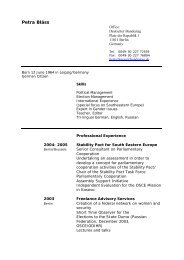What Is the International Monetary Fund? - the JVI eCampus!
What Is the International Monetary Fund? - the JVI eCampus!
What Is the International Monetary Fund? - the JVI eCampus!
You also want an ePaper? Increase the reach of your titles
YUMPU automatically turns print PDFs into web optimized ePapers that Google loves.
- 13 -<br />
national support for <strong>the</strong> program. Such support—or "local ownership"—of <strong>the</strong> program is<br />
critical to its success.<br />
Each program is also designed flexibly, so that, during its implementation, it may be<br />
reassessed and revised if circumstances change. Many programs are, in fact, revised during<br />
implementation.<br />
Instruments of IMF lending and <strong>the</strong>ir evolution<br />
The IMF provides loans under a variety of policies or "facilities" that have evolved over <strong>the</strong><br />
years to meet <strong>the</strong> needs of <strong>the</strong> membership. The duration, repayment terms, and lending<br />
conditions attached to <strong>the</strong>se facilities vary, reflecting <strong>the</strong> types of balance of payments<br />
problem and circumstances <strong>the</strong>y address (see Box 4).<br />
Most of <strong>the</strong> IMF's financing is provided through three different types of lending policies:<br />
Stand-By Arrangements form <strong>the</strong> core of <strong>the</strong> IMF's lending policies. First used in 1952,<br />
<strong>the</strong>y are designed to deal mainly with short-term balance of payments problems.<br />
Medium-term extended arrangements under <strong>the</strong> Extended <strong>Fund</strong> Facility are intended for<br />
countries with balance of payments difficulties related to structural problems, which may<br />
take longer to correct than macroeconomic weaknesses. Structural policies associated with<br />
extended arrangements include reforms designed to improve <strong>the</strong> way economies function,<br />
such as tax and financial sector reforms, privatization of public enterprises, and steps to<br />
enhance <strong>the</strong> flexibility of labor markets. The IMF has been providing concessional lending<br />
to help its poorest member countries achieve external viability, sustainable economic<br />
growth, and improved living standards since <strong>the</strong> late 1970s. The current concessional<br />
facility, <strong>the</strong> Poverty Reduction and Growth Facility (PRGF), replaced <strong>the</strong> Enhanced<br />
Structural Adjustment Facility (ESAF) in November 1999, with <strong>the</strong> aim of making poverty<br />
reduction and economic growth <strong>the</strong> central objectives of policy programs in <strong>the</strong> countries<br />
concerned.



